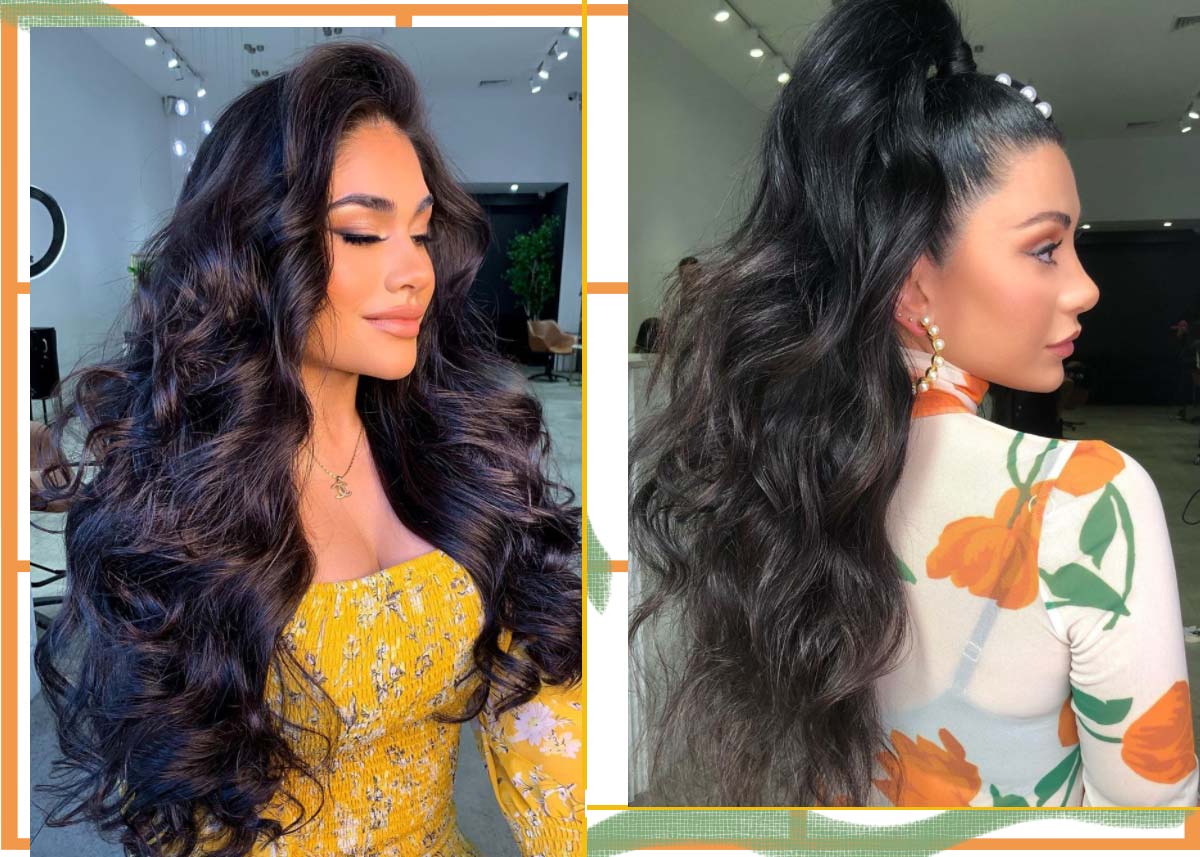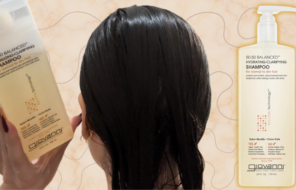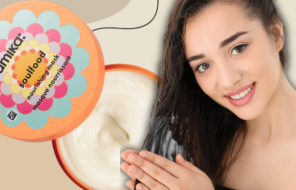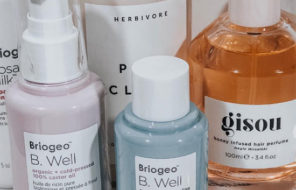- Indigo powder is a plant-derived natural hair dye that gives the hair a brown or dark black color, depending on the starting hair color and the dyeing process.
- It is mostly used in combination with henna to neutralize the red color.
- Indigo hair dye sticks to hair persistently, and you’ll just need root touch-ups every 4-6 weeks.
Indigo powder is your natural hair dye alternative for achieving deep, dark hair. It’s usually used in conjunction with henna, turning the natural red dye into something darker and more neutral. Depending on how it’s used, you can end up with rich brunette locks or with intense raven black hair. If that’s the kind of hair color you dream of, keep reading to learn how to achieve it with this natural hair dye!
To start, we’ve selected the best indigo powders you can buy online. Then we get into all the details about what indigo powder is, how it works, and what are its benefits and drawbacks.
We explain how to dye hair with indigo to achieve the results you want, as well as how to care for it after the fact. Finally, if you’ve already taken the plunge and have some regrets, we also have some tips for fading indigo hair dye from the hair.
In this article:
- 5 Best Indigo Powders for Hair
- What Is Indigo Powder?
- Pros & Cons of Dyeing Hair with Indigo Powder
- How to Dye Hair with Indigo Powder
- How Long Does Indigo Powder Dye Last?
- Indigo Hair Dye Aftercare & Maintenance
- How to Remove Indigo Powder Dye from Hair?
5 Best Indigo Powders for Hair to Try
Ready to get started with indigo hair dye? These are the best indigo powders you can order online!
1. H&C 100% Natural Indigo Powder for Hair
Let’s start with something simple – just an 8 oz bag of indigo powder for hair that you can use however you like. The indigo powder here is nice and smooth, which makes for easy mixing, and it can be applied after you’ve henna’d your hair, mixed with henna, or alone if you’re a brunette wanting to go even darker. Buy it on Amazon!
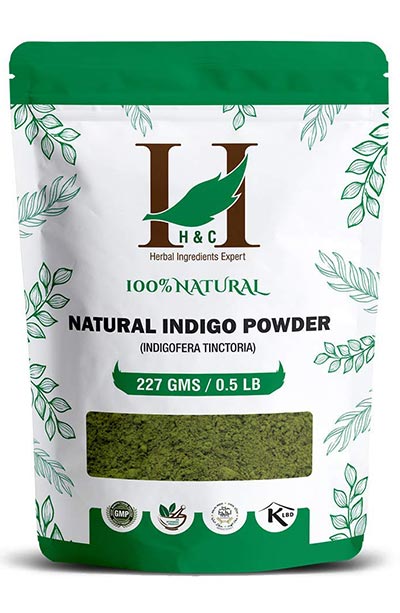
2. The Henna Guys Indigo Powder for Hair Dye/ Color
Sourced from India, this is another fantastic option for indigo hair dye. If it’s your first time trying an indigo powder, the nice thing about this brand is that they give very thorough advice on how to use it. It comes in a few sizes, but if you’re new, you’ll want to start out small with a 7 oz bag. You’ll have to supply your own gloves and brush to apply it. You can get it on Amazon.
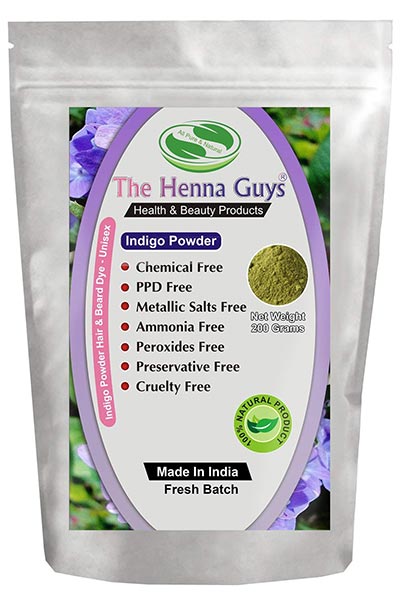
3. Zenia Indigo Powder
This small 3.5 oz bag contains just enough indigo powder for one-time use on long hair or for mixing with henna. As with many other brands, the indigo is sourced from India, and it’s free of any pesticides or fillers – nothing but the simple plant powder. It’s available through Amazon.

4. Mi Nature Natural Indigo Powder
This high-quality indigo powder is another fantastic choice. As with other indigo options, it’s sourced from India. It comes in a biodegradable bag that holds 4 oz of product, so it’s a very eco-friendly choice. Use it with your favorite henna product! Order it online via Amazon!
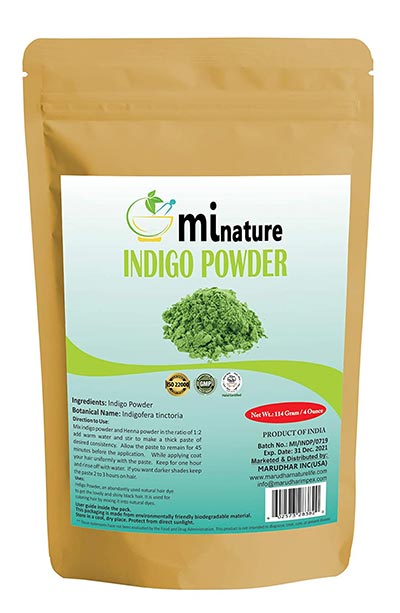
5. Pride of India Herbal Indigo (Indigofera Tinctoria) Hair Color Powder with Gloves
This is the only option on our list that includes a little more than just indigo powder. This product is a blend of indigo, amla, and false daisy. As a result, it’s a little more conditioning to the hair than other indigo powders. It comes in a small plastic tub, which ensures freshness and even includes some gloves! Pick it up from Amazon!

What Is Indigo Powder?
Indigo powder is a natural dye made from the leaves of a plant called Indigofera tinctoria. The dye made from the indigo leaves has been used by humans for thousands of years, especially for dyeing fabric. It was an extremely important commodity for centuries because of its ability to impart a rich blue color. However, when applied to the hair, the indigo plant actually gives off a more complex pigment that can be altered for different effects.
Though the indigo powder initially looks light green, it turns a darker blue-black shade when mixed with water. When applied to the hair, indigo gives it a darker cast of blue-black. This can look amazing when applied over dark brown hair since it turns it nearly black, although, on lighter hair colors, the result can be dull and green-tinged.
Because of this, indigo is most commonly used in conjunction with henna. The two powders can be mixed together, or indigo can be applied after henna, which gives the hair a deeper and more flattering brown or black-brown shade.
Pros & Cons of Dyeing Hair with Indigo Powder
Indigo powder is amazing for the hair, but it’s very different from using typical hair dye. Let’s get into more detail about the pros and cons of using it!
Pros
- Wonderful for darkening the hair
- Much gentler than mainstream dye
- Can be applied in different ways to achieve different effects
- Early animal studies theorize that indigo may help with hair growth
Cons
- Longer process than using traditional dye
- Usually needs to be used along with henna
- Slightly drying to the hair if used without henna (though not as drying as a regular dye)
- Can have a green tinge
- It’s still possible to be allergic to indigo, so patch-testing is important
- Has a strong vegetable smell.
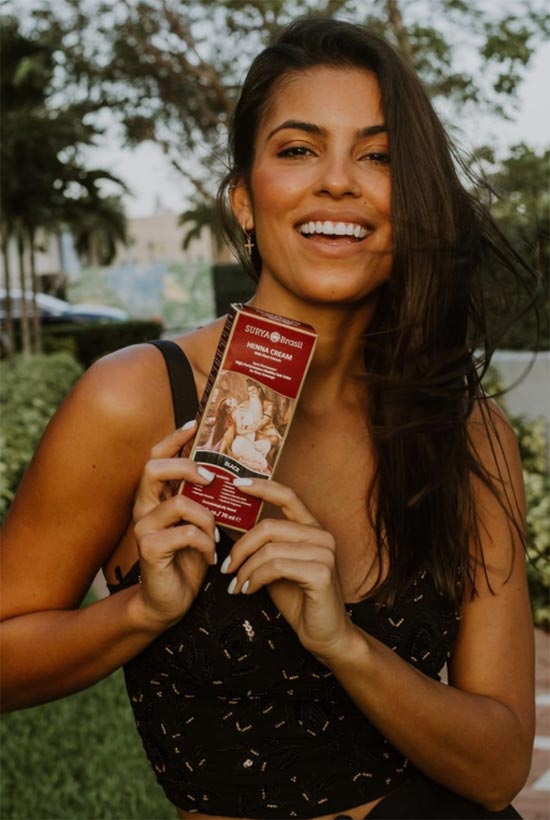
How to Dye Hair with Indigo Powder
We don’t recommend dyeing your hair with just indigo powder since the results can be unpredictable, and your hair might end up looking muddy and green. Instead, it’s much safer to use indigo along with henna! Follow the one-step process to achieve brown hair or go for the two-step process if you want black hair instead.
No matter which process you decide to go with, we always recommend doing a strand test first. Natural hair dyes can be unpredictable, so you can find out exactly what kind of color you can expect by first following the process on a small strand of your hair. You can clip the hair and dye it separately, or you can just dye a small strand of hair towards the back of your head, which will also allow you to determine that you’re not allergic to the henna or indigo powders.
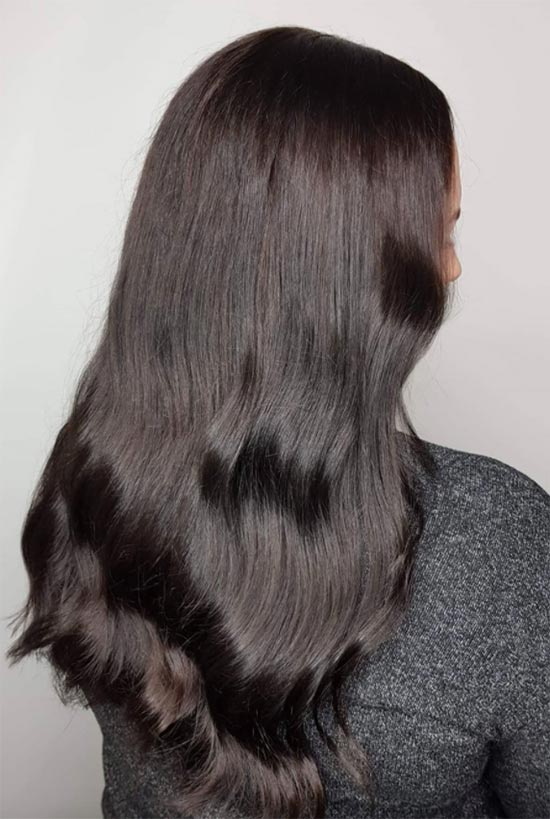
You Will Need
No matter which process you decide to go with, you will need the same set of products and tools:
- Indigo powder
- Henna powder
- Warm water with optional mixers like coffee, lemon juice, salt, or cornstarch
- A non-metal mixing bowl
- A hair dye brush
- Non-metal hair clips
- Disposable or reusable rubber gloves
- Old clothes you don’t mind staining
- Petroleum jelly
- A shower cap or plastic bag
Indigo for Brown Hair: The One-Step Process
This method works best for those with hair that is dark blonde and darker for achieving a deep brunette tone. Blondes will want to prep their hair first by dyeing it with just henna and then to follow this process.
You can adjust the ratio of henna to indigo that you use to customize your color. A 60:40 ratio of henna to indigo will give you a reddish-brown tone, while a 40:60 ratio will be neutral, although this will also depend on your starting hair color.
- The evening before you plan to dye your hair, prepare the henna mixture. Mix the henna with warm water and whatever other mix-ins you choose (we recommend a tablespoon of lemon juice, in particular). The mixture should have a pudding-like consistency. Cover it with cling wrap and leave it somewhere warm to process. It takes 8-12 hours for the henna to release the dye.
- The next day, when you’re ready to dye your hair, gather all of your products and tools. Your hair should be clean and dry without any product in it.
- Next, prepare the indigo mixture. Mix the powder with warm water and add cornstarch and salt if you’d like it to have a smoother consistency. The final mixture should also have a pudding-like consistency. Give the mixture 10 minutes to process.
- While letting the indigo process, get yourself ready. Part your hair into sections and clip them up, put on your gloves and old clothes you don’t mind staining, and spread petroleum jelly around your hairline to prevent the skin from getting stained.
- Once the time has passed, mix together the henna mixture and indigo mixture in a bowl.
- Showtime! Unclip the section of hair you’d like to start with and separate out a smaller piece of hair from it.
- Using your hair dye brush, start applying the indigo and henna mixture to your hair, starting at the roots and spreading it downwards to the ends. Keep doing this until the entire section of hair is covered in dye.
- With your hands, massage the hair a little to make sure the natural hair dye mixture really covers every strand of hair.
- Clip that section back up and move on to the next section, dyeing it in the same fashion.
- Once all of your hair is saturated with the henna and indigo hair dye, pop on a shower cap or plastic bag and give the hair time to take in the dye. This will usually take around 2-4 hours, depending on how dark and intense you want the color to be. The longer you wait, the more intense the final result will be.
- Once enough time passes, hop in the shower and rinse out the dye. Don’t use shampoo, just lukewarm water. It may take you a few rinses to get all of the color out.
- You can condition your hair if you feel it’s necessary, although it’s not mandatory at all since the henna itself is quite moisturizing.
- Once out of the shower, you can let your hair dry naturally or blow-dry it on low heat and then check out your new brunette look!
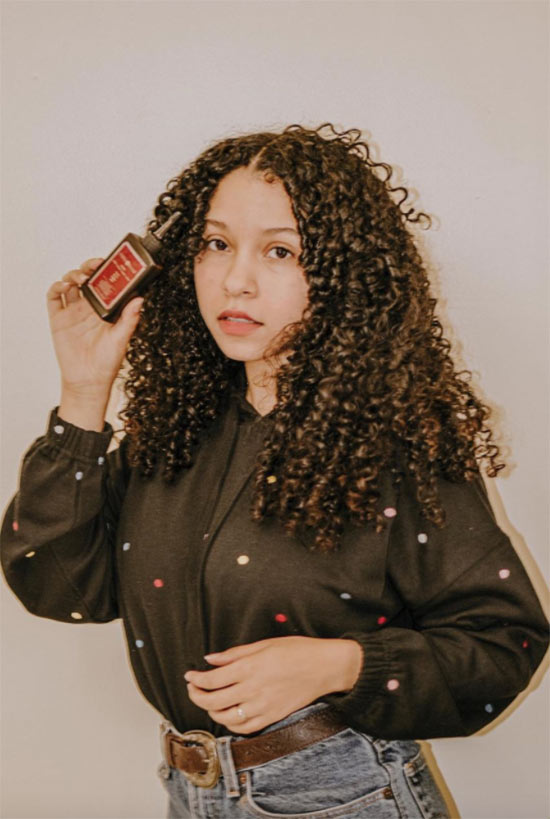
Indigo for Black Hair: The Two-Step Process
If your goal is to have dark black hair, you’ll want to try the two-step process instead. In this step, instead of mixing the indigo and henna together, you first dye your hair with just henna and then follow it up with indigo. Another option is to dye the hair with a mix first, like in the one-step process, and then to follow it up with another coat of just indigo.
This method works just as well as for those with lighter hair as it does for those with dark hair, although those with lighter hair might end up with more of a dark brown color the first time they try it. It might take a few repeats to finally saturate the hair with enough pigment to achieve black hair.
- First, dye your hair with henna hair dye, per our guide to henna hair dye.
- Three days to a week later (after the henna has finished developing in your hair), you’ll be ready to apply the indigo hair dye!
- Make sure you have everything you’ll need already set up since indigo hair dye processes fairly quickly. Put on clothes you can stain and make sure you have all of your tools in front of you, so you don’t have to go running and searching while the indigo dye loses its efficacy.
- Once you’re ready to start, pour your indigo powder into a bowl and then add enough warm water for the mixture to take on a yogurt-like consistency. Add a bit of cornstarch and salt for even better results.
- Set the mixture aside for ten minutes, and in the meanwhile, clip up your hair into sections, put on gloves, and protect your skin with petroleum jelly, just like you did when dyeing your hair with henna.
- Once ten minutes pass, start applying your indigo to the hair in sections like you did when applying the henna mixture.
- Once your entire head is covered in indigo hair dye, and all of your hair is clipped up, put on a shower cap and give the indigo powder time to do its magic. It usually takes around 2-4 hours, just like with henna.
- Once the time passes, wash the indigo out with lukewarm water. Take your time and rinse the hair thoroughly to make sure there is no product left behind.
- Finally, if your hair feels a little dry, you can condition it.
- Once you’re out of the shower, let your hair dry and then admire your new, raven-haired look!
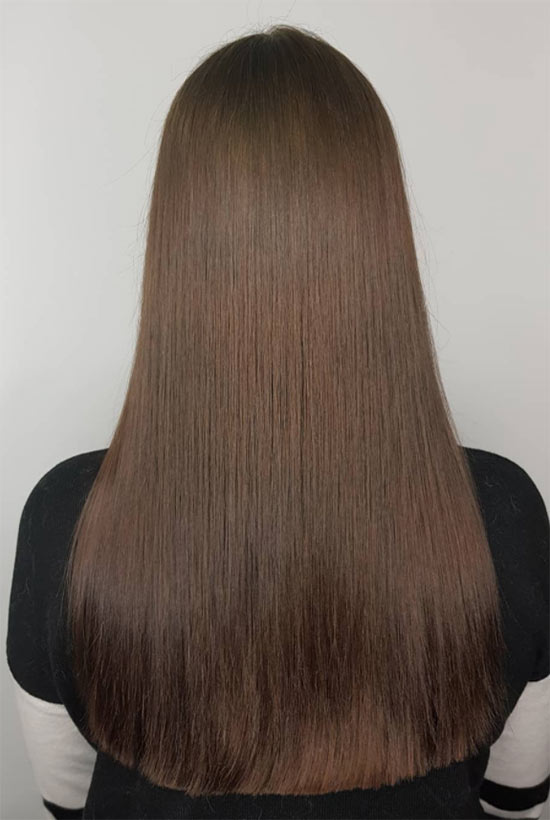
How Long Does Indigo Powder Dye Last?
Assuming you’ve followed a 2-step process, indigo hair dye is usually permanent, so your hair will not get lighter, though its tint may fade a bit. Some people notice that after a few weeks, their indigo slightly fades and reveals more of the henna, so the hair looks warmer, but this really depends on the individual and their hair chemistry.
More often than not, indigo will stay in the hair permanently, so only once your roots grow out will you need a touch-up. Touch-ups are usually necessary every 6-8 weeks.
Indigo Hair Dye Aftercare & Maintenance
Taking care of indigo hair dye is a lot like maintaining other hair colors. The only difference is that your hair will already be in a healthier condition right from the start!
- In general, you should try and limit how often you wash your hair since any instant of shampoo will cause some color to fade.
- Hot water is also known to leach color out of the hair, so keep your showers at a lukewarm temperature. As a bonus, your skin will also thank you!
- When you do shampoo your hair, it’s always best to use a gentle, sulfate-free shampoo.
- Avoid processing your hair with too much heat, and instead, stick to letting it air-dry or blow-drying on a low setting.
- If you like to swim in the pool, saturate your hair with water or even a leave-in conditioner, and then put on a swim cap before getting in the water. This way, your hair will be protected from the color-altering effects of chlorine.

How to Remove Indigo Powder Dye from Hair?
Unlike with pure henna hair dye, the problem with indigo powder dye is that it has a green-blue base. This means that when you try to remove or fade it, it can leave your hair looking green. There are a ton of success stories out there of people who managed to remove henna from hair, but there are nearly no success stories when it comes to indigo.
Your best bet when it comes to fading hair dyed with indigo is to combine regular use of a stripping, sulfate-based shampoos with deep oil treatments using oil like grape seed oil, coconut oil, or olive oil.
Simply start using a harsher shampoo in the shower (the exact kind of shampoo you shouldn’t use when you want to maintain your color!), and once or twice a week, saturate your hair with your oil of choice, wrap it up in a shower cap, and then apply heat with a blow dryer. Leave the oil in the hair overnight, and then wash it out in the morning with that stripping shampoo.
Another thing you can try is Color Oops, which is an ammonia- and bleach-free color remover. It is the product that is going to remove as much of the indigo powder as possible with as little damage. However, even with a product like Color Oops, we can’t guarantee that you’ll be able to avoid the dreaded muddy-green look, though it has worked for some.
Photos via @natalieannehair, Instagram

